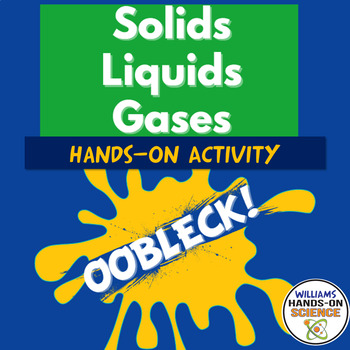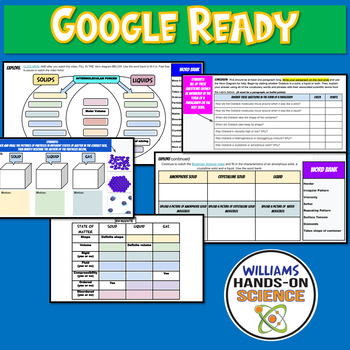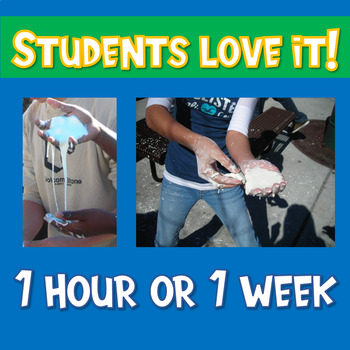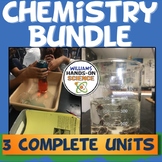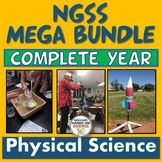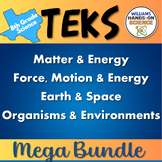Physical Chemical Changes Solids Liquids Gases 5E Activity Oobleck MS-PS1-1
- Zip
What educators are saying
Also included in
- This NGSS bundle has everything you need for Structure and Properties of Matter (complete distance learning unit), PS1.B PS3.A Chemical Reactions Google Ready Bundle (complete distance learning unit) Chemical Reactions, Definitions of Energy, States of Matter, Periodic Table, Chemical Reactions, ConPrice $69.97Original Price $115.20Save $45.23
- This bundle is a time-saving, comprehensive and user-friendly complete year bundle for physical science Teachers that will streamline your teaching experience effortlessly! Every lesson is meticulously planned and just a click away. This extraordinary bundle is a treasure trove of engaging resourcesPrice $176.00Original Price $311.50Save $135.50
- The TEKS 8th Grade Bundle is a comprehensive resource for teaching science mainly in Texas, but it can be used in any state. This bundle includes over 60 hands-on, rigorous, engaging, and phenomena-driven lessons that cover the TEKS standards for 8th grade science. The lessons are designed to help sPrice $160.00Original Price $321.15Save $161.15
Description
Oobelck (corn starch and water) will blow your student’s minds!!! This is a timeless lab that I have been using since 2000, but I have modified it into a cutting edge lesson. This lab includes five total activities, so you can modify it from 1 hour to 1 week. It hits multiple learning styles with YouTube links, Venn Diagram, a lab activity, graphic organizers, word banks, sentence starters, a science article with a Common Core Claim Evidence Reasoning Chart, an assessment and a key to everything, all in the lesson style of 5E. I also added a Google Ready version for a distance learning option
THIS RESOURCE IS GOOGLE READY
THIS PRODUCT INCLUDES THE FOLLOWING CONCEPTS:
Matter
Molecules
Energy
Mixtures
Homogeneous
Heterogonous
Characteristics of Solids
Characteristics of Liquids
Characteristics of Gasses
Crystalline Solid
Amorphous Solid
Viscosity
This bundle includes the following NGSS standards:
TERMS OF USE
• All rights reserved by Williams Hands On Science, Inc.
• This product is to be used by the original purchaser only.
• Intended for classroom and personal use only.
• Copying for more than one teacher, classroom, department, school, or school system is prohibited.
• This product may not be distributed or displayed digitally for public view.
• Failure to comply is a copyright infringement and a violation of the Digital Millennium Copyright Act (DMCA).
If there are any errors or questions, please contact me through TpT or email me at:
williamshandsonscience@gmail.com
Thanks for purchasing this product and please email me with any questions:
williamshandsonscience@gmail.com
Related Products ⭐ Distance Learning MS-PS1-1 HS-PS1 NGSS Periodic Table Computer Lab Google ⭐ Distance Learning MS-PS1-5: Conservation of Mass Chemical Reactions Online ⭐ Distance Learning MS-PS1: States of Matter Worksheet Online Lab Google Ready ⭐ Google Coronavirus Molecule Structure Claim Evidence Reasoning Distance Learning ⭐ Google Elements Atoms Compounds Molecules Card Sort Worksheet Distance Learning ⭐ Graphic Organizer and PREZI for Periodic Table ⭐ Integrated NGSS Forces & Energy Bundle MS-PS2-1 & 2 MS-PS3 4 & 5 PS2.A PS2.B ⭐ Integrated NGSS MS-PS1-4: Heat Transfer, Conduction, Convection, Climate ⭐ MS-PS1-1 MS-PS1-2 MS-PS1-5 Matter Chemical Physical Changes C.E.R. ⭐ MS-PS1-1: Bohr Model Atom Diagrams: Structure and Properties of Matter ⭐ MS-PS1-5: Chemical Physical Change Diet Coke & Mentos 5e Close Reading Modeling ⭐ MS-PS1-5: Chemical Reactions Simulation Conservation of Mass Close Reading Notes ⭐ MS-PS1: Elements Atoms Compounds Molecules Card Sort Worksheet & Close Reading ⭐ MS-PS3-5 NGSS Kinetic Potential Energy Card Sort Worksheet Distance Learning ⭐ NGSS 5E Conservation of Mass Lab Climate Change & Cloze Notes ⭐ NGSS 5E Matter Lab Computer Simulation Close Reading Close Notes & Warm Up ⭐ NGSS 46 Slide Matter PowerPoint with Warm Ups and Guided Notes PS1.A ⭐ NGSS Energy Transfer Chemistry of Ice Cream Lab Reading Cloze Notes PS1.A PS3.A ⭐ NGSS Flipping the Classroom with Frayer Periodic Table and PREZI ⭐ NGSS MS-PS1-1: 5E Oobleck Lab Claim Evidence Reasoning Graphic Organizer ⭐ NGSS MS-PS1-1: Molecule Building Lab Elements Atoms Compounds Molecules Formulas ⭐ NGSS MS-PS1-5: Chemical Vs. Physical Change Distance Learning Optional Activity ⭐ NGSS Middle School Chemistry Bundle PS1.A PS1.B PS3.A PS3.B ⭐ NGSS PS1.A Magic Milk Lab Developing and Using Models Molecules Compounds ⭐ NGSS PS1.A Structure and Properties Science Doodle PowerPoint Google Ready Notes ⭐ NGSS PS1.B Chemical Reactions Doodle Test Christmas ⭐ NGSS Structure & Properties of Matter Editable Study Guide & Test PS1.A PS3.A ⭐ NGSS Structure & Properties of Matter Study Guide Worksheet Graphic Organizer ⭐ NGSS Structure & Properties of Matter Vacuum in a Can Lab Modeling & Warm Up ⭐ PS1.A PS1.B Chemical Reactions Science Doodle Scaffolded Notes PowerPoint ⭐ Periodic Table Baby Book

